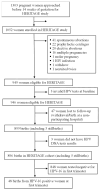Association between Human Papillomavirus 16 Viral Load in Pregnancy and Preterm Birth
- PMID: 38400073
- PMCID: PMC10892609
- DOI: 10.3390/v16020298
Association between Human Papillomavirus 16 Viral Load in Pregnancy and Preterm Birth
Abstract
Recent evidence shows increased preterm birth risk with human papillomavirus-16 (HPV16) infection during pregnancy. This study aimed to measure the association between HPV16 viral load during pregnancy and preterm birth. We used data from participants in the HERITAGE study. The Linear Array assay was used for HPV DNA testing on vaginal samples collected during the first and third trimesters of pregnancy. The HPV16 viral load was measured with a real-time polymerase chain reaction. We used logistic regression to measure the associations between HPV16 viral load during pregnancy and preterm birth (defined as birth before 37 weeks of gestation). The adjusted odd ratios (aORs) and the 95% confidence intervals [CIs] were estimated with inverse probability treatment weighting of the propensity score. This study included 48 participants who tested positive for HPV16 during the first trimester of pregnancy. The aOR for the association between first-trimester HPV16 viral load (higher viral load categorized with a cutoff of 0.5 copy/cell) was 13.04 [95% CI: 1.58-107.57]). Similar associations were found using different cutoffs for the categorization of viral load during the first and third trimesters. Our findings suggest a strong association between a high HPV16 viral load during pregnancy and preterm birth, demonstrating a biological gradient that reinforces the biological plausibility of a causal association.
Keywords: HPV16; human papillomavirus (HPV); pregnancy; preterm birth; viral load.
Conflict of interest statement
F.C. has received funds through the research center of the CHUM to evaluate HPV detection tests through his institution from Becton-Dickson and Roche Molecular systems. H.T. has received occasional lecture fees from Merck and unrestricted grants form ViiV Healthcare. All other coauthors have no conflict of interests.
Figures


References
-
- WHO Preterm Birth. [(accessed on 10 January 2024)]. Available online: https://www.who.int/news-room/fact-sheets/detail/preterm-birth.
-
- Chawanpaiboon S., Vogel J.P., Moller A.-B., Lumbiganon P., Petzold M., Hogan D., Landoulsi S., Jampathong N., Kongwattanakul K., Laopaiboon M., et al. Global, regional, and national estimates of levels of preterm birth in 2014: A systematic review and modelling analysis. Lancet Glob. Health. 2019;7:e37–e46. doi: 10.1016/S2214-109X(18)30451-0. - DOI - PMC - PubMed
-
- Government of Canada Preterm Birth Initiative. [(accessed on 10 January 2024)]. Available online: https://www.canada.ca/en/institutes-health-research/news/2017/05/preterm....
MeSH terms
Substances
Grants and funding
LinkOut - more resources
Full Text Sources

